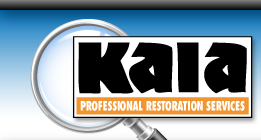EMERGENCY TIPS
Do's and Don'ts During Times of Disaster
Many homeowners find that when they experience a loss, whether it is a water loss or a fire, they have no idea what to do. They call their insurance company and are told to do whatever they can to stop the damage or mitigate the loss. Calling Kala, a certified Damage Restoration Contractor, is certainly a good first step to consider. Kala can handle everything from emergency water extraction, emergency board ups, roof tarps and any insurance related claims. Kala's team is available 24 hours a day, 7 days a week. We are experts in the field of insurance repair, so call us for any emergency needs.
Phone: (866)-525-8119
Here are some tips for the homeowner should they experience a water damage or fire damage loss:
Do's & Dont's of Water Damage
Do's
- If the outside temperature is above 60 degrees, use dehumidifiers if available.
- Use fans to circulate the air and assist drying.
- Remove as much water as possible by mopping and blotting.
- Wipe furniture dry.
- lift draperies off carpet, loop through a coat hanger, and place the hanger on the drapery rod.
- Prop up wet furniture cushions for even drying and place small wood blocks or aluminum foil under furniture legs.
- Remove wet area rugs or other floor coverings.
- Open furniture drawers, closet doors, and luggage to enhance drying.
- Move photos, paintings, and art objects to a safe, dry location.
- Remove wet fabrics and dry them as soon as possible. Hang furs and leather goods to dry separately at room temperature.
- Remove damp books from shelves and spread out to dry.
- If damage occurs during a cool season, leave heat on; if in summer, use an air conditioner, if available.
Don'ts
- Do not use an ordinary household vacuum to remove water.
- Do not use electrical appliances while on wet carpet or wet floors
- Do not go into rooms with standing water if the electricity is still on.
- Do not lift tacked down carpet without professional help. Lifting the carpet incorrectly could promote shrinkage.
Sewage & Flood Damage
Do's
- Treat all water-impacted surfaces and furnishings as toxic, until properly decontaminated.
- Keep children and pets out of contaminated areas.
Do Not
- Track contaminated material into undamaged areas
- Attempt to decontaminate surfaces with sprays and other over-the-counter germicidal products, which may not fully disinfect contaminated surfaces.
The Things You Need To Know About Mold
- Potential health effects and symptoms associated with mold exposures include allergic reactions, asthma, and other respiratory complaints
- There Is no practical way to eliminate all mold and mold spores in the indoor environment - The way to control indoor mold growth Is to control moisture!
- If mold is a problem in your home or office, you must clean up the mold and eliminate sources of moisture
- Fix the source of the water problem or leak to prevent mold growth
- Reduce indoor humidity (to 30-80% ) to decrease mold growth by:
- venting bathrooms, dryers, and other moisture-generating sources to the outside
- using air conditioners and de-humiditlers
- increasing ventilation
- using exhaust fans whenever cooking, dishwashing, and cleaning
- Clean and dry any damp or wet building materiale and furnishings within 24-48 hours to prevent mold growth
- Clean mold off hard surfaces with water and detergent end dry completely. Absorbent materials such as ceiling tiles, that are moldy, may need to be replaced
- Prevent condensation: Reduce the potential for condensation on cold surfaces (ie., windows, piping, exterior walls, roof, or floors) by adding Insulation
- In areas where there is a perpetual moisture problem, do not install soft floor covering (ie. bathrooms with leaks or frequent condensation)
- Molds can be found almost anywhere. They can grow on virtually any substance, providing moisture is present. Molds can grow on wood, paper, carpet foods, drywall and dust.


